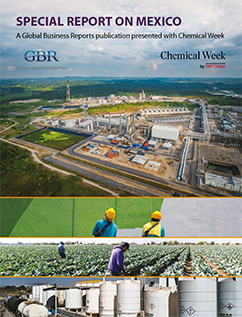Specialty Chemicals in Mexico: Feedstock shortages drive new entrants into the market
RELATED PUBLICATION
ARTICLES FROM THIS PUBLICATION
Specialty Chemicals in Mexico

Image courtesy of Covestro
Falling commodity prices have accelerated the trend of companies reorienting towards the specialty chemicals market. Companies are expanding their offerings of innovative, low volume products to meet demand in specific growing niches. The post-pandemic specialty chemicals industry is one marked by increasing regionalization of supply chains, innovation in processes, and a focus on trends specific to the Mexican market.
Some niches are doing better than others. During the pandemic, there was a major boom in demand for personal care products such as disinfectants, and that demand has continued even as Covid has become less of a concern. The habits inculcated by the pandemic in terms of both personal and industrial disinfection have continued. Federico Soto, general director of Organo Síntesis, said: “For those of us in the personal care market for disinfection and water treatment, the rebound began in October 2023, so we expect that in 2024 we will see pre-pandemic levels of sales.”
Proquipusa is another company in the personal care and disinfectants market, offering specialty products ranging from detergent products for the automotive industry to specialty creams for cosmetics. The company’s new detergent for the automotive industry cleans and maintains metallic machinery parts with a new application that saves automakers three distinct cleaning phases. Luis Espinosa Rueda, general manager of Proquipusa, said, “We want to keep growing in some of the new markets we have identified as targets, such as detergents with nanotechnology properties.”
The personal care sector is one in which Mexico is experiencing noticeable growth. According to Statista, the Mexican personal care market is expected to reach a market volume of US$4.14 billion in 2024. This has led to tangible investment, with companies seeking to take advantage of Mexico’s geographic position and large market. “Mexico as a country has a very matured and experienced manufacturing Industry and has the right competitive advantages to become the first supplier for various markets in the US, and we believe that the consumer and life sciences markets are some of them,” said Rafael Méndez, vice president of Croda LATAM.
Although the market for specialty chemicals for personal care has grown rapidly during and after the pandemic, Mexico’s perennial engine of growth, the automotive industry, remains a crucial segment for specialty chemicals producers. The automotive industry uses plastics, coatings, and a variety of other chemicals, but it also drives chemical demand through the income it provides to the country. Maggie Gómez-Rábago, CEO of Charlotte Chemical, said: “As the automotive industry grows, people have money to spend on goods and on building houses, further driving the demand for specialty chemicals.”
Covestro, a German company that produces polyurethane and products for coatings and adhesives, offers products primarily used in the automotive industry. The company, which has two sites and a team of over 300 in Mexico, has experienced growth in the automotive area. To continue that growth, Covestro has prioritizes R&D in areas such as coatings. “For the automotive industry, lowering weight is essential because the weight of the car is a key factor in the car’s energy consumption,” stated Arturo Molina, managing director of Covestro. “In Covestro’s coatings section, we offer products that require a thinner layer of paint but simultaneously reflect more energy and consumption.”
Momentive, a silicone producer, is investing in its presence in the automotive industry. “One of Mexico’s strongholds has always been the automotive industry,” said Eduardo Cortes, CEO of Momentive. “It is one of our key segments, and we are envisioning ways to support the future with new electric and autonomous vehicles.”
Regionalization of supply chains
With stricter demand from consumers for sustainable products, managing supply chains has become crucial. For consistent production and growth, the chemical industry must have a secure domestic supply chain. For some companies, the most effective way to manage supply chains is to develop the raw materials themselves. Dresen Química, a manufacturer of animal and human nutrition products, now produces its own raw materials for its natural antioxidants. For example, the company cultivates the rosemary for rosemary extracts. Jose Arturo Paulín, CEO of Dresen Química, said: “We have brought the whole supply chain in-house, which allows us to better monitor it and make sure that things are being done responsibly.”
Nostalgia and indulgence: Emotions drive flavors and fragrances
Flavors and fragrances emotionally resonate with consumers, and are among the most personal of chemical products, with consumers coming into contact with the products in everything from shampoos to snacks. For Mexicans, a desire for comfort is driving sales. “A major trend, accelerated by the pandemic, has been demand from consumers in Mexico for products based on traditional Mexican food and drink culture,” said Cecilia Paredes, country managing director for Bell Flavors & Fragrances. “People are embracing their heritage, and there is a strong demand for traditional flavors such as tamarind and hibiscus.”
The demand for plant-based products is part of a global shift in consumer conscience, which
has a dramatic impact on the industry. Cristophe Enice, managing director of Robertet, explained: “There is a global consumer trend towards healthier products, so our technologies and natural products are in high demand.”
Robertet has seen success in its expanded flavor enhancers line, benefiting in part from government regulation driving healthier food. “Our sweetener enhancers, salt reduction and fat reduction technologies are doing very well,” said Enice. “It has been three years since the Mexican government introduced a new labelling regime on products with salt, sugars, and fats, which has been a boon for the industry as producers look to reduce the levels of them in their products.”
Both globally and domestically, fragrances and flavors regulation has become stricter. The International Fragrance Association, which regulates ingredients used in the industry, recently updated its code of practice. The changed regulations have increased the number of ingredients classified as allergenic from 26 to more than 86 ingredients.
COFEPRIS regulations on drug precursors have been challenging to manage. Industry players support the government’s efforts to handle the issue and are working with the associations to develop more flexible arrangements regarding controls. “Most of the materials that we use to produce legitimate products are designated as precursor materials for the production of these illegal goods, which complicates and slows down their importation, warehousing, and approvals,” explained José Arias of AZ Fine Chemicals, a supplier of raw materials to the flavors and fragrances industry. “This has been time-consuming and costly.”












